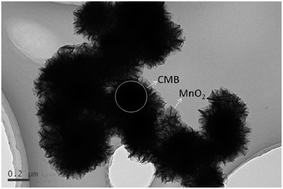Nanoflaky MnO2 grown in situ on carbon microbeads as an anode material for high-performance lithium-ion batteries†
Abstract
A flower-like MnO2 encapsulated carbon microbead (MnO2@CMB) nanocomposite is firstly synthesized via in situ nucleation and growth of birnessite-type MnO2 on the surface of monodisperse carbon microbeads. The structure, morphology and performance of the samples are characterized by powder X-ray diffraction (XRD), scanning electron microscopy (SEM), and galvanostatic charge/discharge. The results reveal that the flower textured MnO2@CMB nanocomposite is composed of a CMB core and a MnO2 nanosheet shell. As the anode material for lithium-ion batteries, the MnO2@CMB nanocomposite exhibits excellent electrochemical performance. It shows a good rate capability of 230 mA h g−1 at a current density of 1500 mA g−1 and a large reversible capacity of 620 mA h g−1 without capacity fading for the 80th cycle at 100 mA g−1, which is much better than those of pure MnO2 and graphite. The superior electrochemical performance can be attributed to the unique hierarchical architecture and the combinative effects of the MnO2 nanosheet and carbon matrices.


 Please wait while we load your content...
Please wait while we load your content...